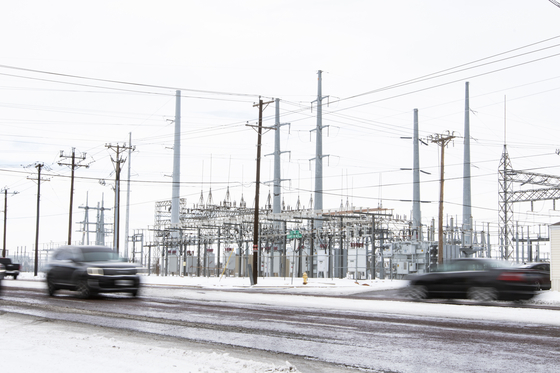![A record cold wave in Texas has caused a power crisis, causing serious disruptions to industrial production. Pictured is a Texas power facility. [AP=연합뉴스]](https://i0.wp.com/pds.joins.com/news/component/htmlphoto_mmdata/202102/18/f2ff6b49-77c2-479a-b6d6-2d93bddd9bcd.jpg?w=560&ssl=1)
A record cold wave in Texas has caused a power crisis, causing serious disruptions to industrial production. Pictured is a Texas power facility. [AP=연합뉴스]
The bad news was in the semiconductor market, which is already suffering from a shortage of supply. A large-scale power outage occurred due to the cold wave and earthquake, leading to a situation in which semiconductor factories around the world were closed.
Supply shortage semiconductor market to make matters worse
In the worst cold weather, power outages, set up factories
Samsung’s production disruption for at least one week is inevitable
Japanese Renesas also stopped due to earthquake
Samsung Electronics’ semiconductor plant in Austin, Texas, USA, has been shut down at 3 pm (local time) on the 16th. This is because a cold wave of -17 degrees Celsius continued for two weeks in this area, and snow accumulated over 12 cm, resulting in a power crisis. It is said that many of the wind power generators, the main source of power, have also failed. The city of Austin requested that Samsung Electronics, Infineon, NXP, and Tesla stop the operation of the factory due to the lack of power.
The city of Austin has notified that electricity will be shut down for three days, but the period of power outages may be lengthened depending on weather conditions. Samsung Electronics explained, “For the safety of residents, we have accepted the suspension of electricity supply to the city of Austin.” “The timing of restarting (factory) has not been decided yet.” Samsung Electronics said that the amount of damage was not large because it was a predicted power outage. Inside and outside the company, production disruption for at least a week is expected to be inevitable.

The growing global semiconductor market. Graphic = Reporter Jaemin Shin [email protected]
Samsung Electronics’ Austin plant (area 1221,000m2) has a foundry (consignment production) production line. The workforce is about 3,000. The application processor (AP) in smartphones is the main product. Samsung Electronics invested over 18 trillion won in this factory. The industry sees that Samsung Electronics is considering an additional 17 billion dollars (about 19 trillion won) investment.
On the 13th, a strong earthquake of magnitude 7.3 occurred off the coast of Fukushima Prefecture, Japan, and the Japanese Renesas Ibaraki Plant was shut down. Renesas is the world’s third largest automotive semiconductor company. The plant, which is Renesas’ flagship production base, has the only 12-inch wafer assembly line. Currently, the power supply to the plant has resumed, but production has stopped because it requires checking for damage to manufacturing equipment and products. In the semiconductor industry, it will be difficult to operate the Renesas plant for at least a month or two.
In December of last year, an earthquake of magnitude 6.7 occurred in the waters of northeastern Taiwan, resulting in a power outage at the TSMC plant in Taiwan, the world’s number one foundry company. Micron Technology’s Taiwan plant, an American DRAM maker, also stopped operating the plant and restarted it due to power cuts.
Jae-Sung Choi, a professor at the Department of Semiconductor Equipment Engineering at Far East University, said, “Semiconductor factories dealing with microprocessing must re-inspect the facilities when the production line stops, and then create a new (production) environment. Stopping just one day could cause tens to hundreds of billions of billions of damage.” When a power outage occurred at Samsung Electronics’ semiconductor plant in Pyeongtaek, Gyeonggi-do in 2018, it is said that it lost 50 billion won in 30 minutes of shutdown.
The industry is concerned that the supply shortage of semiconductors could worsen. NXP, which has a plant in Austin, Texas, ranks first in the world for automotive semiconductors, and Infineon ranks second in the world. Even today, automakers such as General Motors and Ford and Volkswagen are experiencing production disruptions due to the lack of automotive semiconductors. Market research firm IHS Markit predicted a production disruption of about 1 million units worldwide in the first quarter of this year alone due to a shortage of automotive semiconductors.
The shortage of semiconductor supply may lead to higher prices. Renesas announced that it will increase the price of analog and power semiconductors as of the 1st of last month. The Nippon Geizai newspaper reported that TSMC plans to gradually raise the price of semiconductors for vehicles by up to 15% from the end of this month. The Dutch NXP also announced a price increase.
Ahn Ki-hyun, executive director of the Korea Semiconductor Industry Association, predicted that “the supply of the foundry will be more scarce and the demand is lined up, so the price will increase further.”
Reporter Choi Hyun-joo [email protected]
